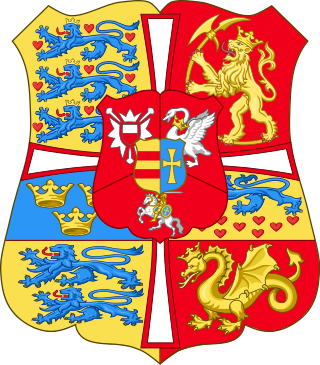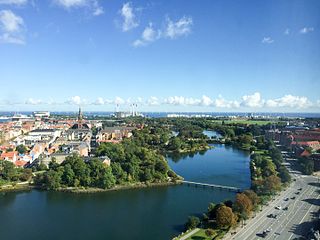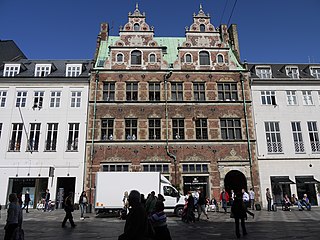Contents
- Incumbents
- Events
- Full date missing
- Births
- Full date missing 2
- Deaths
- Full date missing 3
- References
| |||||
| Decades: | |||||
|---|---|---|---|---|---|
| See also: | Other events of 1690 List of years in Denmark | ||||
Events from the year 1690 in Denmark
| |||||
| Decades: | |||||
|---|---|---|---|---|---|
| See also: | Other events of 1690 List of years in Denmark | ||||
Events from the year 1690 in Denmark

Christian VII was a monarch of the House of Oldenburg who was King of Denmark–Norway and Duke of Schleswig and Holstein from 1766 until his death in 1808. For his motto he chose: "Gloria ex amore patriae".

Frederick IX was King of Denmark from 1947 to 1972. Born into the House of Glücksburg, Frederick was the elder son of King Christian X and Queen Alexandrine of Denmark. He became crown prince when his father succeeded as king in 1912. As a young man, he was educated at the Royal Danish Naval Academy. In 1935, he was married to Princess Ingrid of Sweden and they had three daughters, Margrethe, Benedikte and Anne-Marie. During Nazi Germany's occupation of Denmark, Frederick acted as regent on behalf of his father from 1942 until 1943. Frederick became king on his father's death in early 1947. During Frederick IX's reign Danish society changed rapidly, the welfare state was expanded and, as a consequence of the booming economy of the 1960s, women entered the labour market. The modernization brought new demands on the monarchy and Frederick's role as a constitutional monarch. Frederick IX died in 1972, and was succeeded by his eldest daughter, Queen Margrethe II.

Frederick V was King of Denmark–Norway and Duke of Schleswig-Holstein from 6 August 1746 until his death in 1766. He was the son of Christian VI of Denmark and Sophie Magdalene of Brandenburg-Kulmbach.

Amalienborg is the official residence for the Danish royal family, and is located in Copenhagen, Denmark. Queen Margrethe ll resides in the palace during winter and autumn. It consists of four identical classical palace façades with rococo interiors around an octagonal courtyard ; in the centre of the square is a monumental equestrian statue of Amalienborg's founder, King Frederick V.
Events from the year 1905 in Denmark.
Events from the year 1906 in Denmark.

Christianshavns Vold is a former rampart which was part of the bastioned fortification ring which used to surround Copenhagen, Denmark. Running along the full south-eastern perimeter of Christianshavn and Holmen, it used to form a protective barrier towards the island of Amager. It consists of earthworks with 12 bastions and in front of it ran a moat, Stadsgraven, now forming a broad canal which separates Christianshavn from the rest of Amager. On the other side of Stadsgraven. on Amager, was a lower system of outworks called Christianshavns Enveloppe of which only the northern half survives. Along with Kastellet on the other side of the harbour, it is the only intact part of the fortification system.

Amaliegade is a street in central Copenhagen, Denmark, which makes up the longer of the two axes on which the Rococo district Frederiksstaden is centred. Amaliegade extends from Sankt Annæ Plads to Esplanaden, passing through the central plaza of Amalienborg Palace on the way where it intersects Frederiksgade, the other, shorter but more prominent, axis of the district.

Jacob Fortling was a German-Danish sculptor, architect and industrialist, described as one of the most industrious people in the Denmark of his day. He came to Denmark at age 18 and embarked on a successful career, first as a sculptor and later also as an architect. He was also engaged in the production of building materials, owning several quarries in Norway. Just outside Copenhagen, on Amager's east coast, he founded Kastrup Værk, a large industrial facility combining a lime plant, a brickyard and a pottery.
Events from the year 1819 in Denmark.
Events from the year 1829 in Denmark.
Events from the year 1866 in Denmark.
Events from the year 1873 in Denmark.
Events from the year 1736 in Denmark.
Events from the year 1752 in Denmark.

Katholm Castle is a manor house located on the Djursland peninsula, six km south of Grenaa, in eastern Denmark. Built in the Renaissance style from 1588 to 1591 and expanded in 1622, it is set on a castle bank in the middle of an artificial lake in a forested area. Wilhelm Dinesen, father of writer Karen Blixen, spent his childhood years at Katholm.
Events from the year 1681 in Denmark.

The Matthias Hansen House, formerly also known as the Schoustrup House is a Renaissance-style townhouse on Amagertorv in central Copenhagen, Denmark. Built in 1616, it is one of few buildings of its kind which has survived the Copenhagen Fires of 1728 and 1795. The building is now home to a flagship store for the Royal Copenhagen porcelain factory.
Events from the year 1692 in Denmark
Wilhelm August van der Osten was a Danish civil servant.